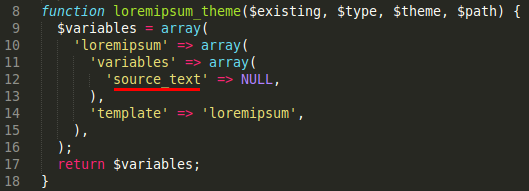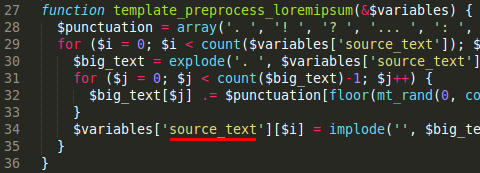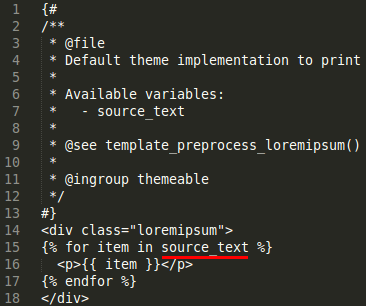Een themasjabloon toevoegen aan een Drupal-module
Deel III van de praktische handleiding voor het maken van basis Drupal 8-modules
Van .info tot tests, alleen de basis
loremipsum.module
/**
* Implements hook_theme().
*/
function loremipsum_theme($existing, $type, $theme, $path) {
$variables = array(
'loremipsum' => array(
'variables' => array(
'source_text' => NULL,
),
'template' => 'loremipsum',
),
);
return $variables;
}
Een andere reden om het .module-bestand niet weg te laten is dat hook_theme() daar moet worden geplaatst. Dit werkt bijna hetzelfde als in D7: u declareert een array die uw variabelen en het sjabloonbestand bevat, dat op de juiste plek (de map templates) moet worden opgeslagen met de extensie .html.twig.
Vervolgens kunt u, voordat u de render-array naar Twig doorgeeft, een preprocess uitvoeren. De volgende hook voegt willekeurige leestekens toe aan het einde van elke zin:
/**
* Template preprocess function for Lorem ipsum.
*
* @param array $variables
* An associative array containing:
* - source_text
*/
function template_preprocess_loremipsum(&$variables) {
$punctuation = array('. ', '! ', '? ', '... ', ': ', '; ');
for ($i = 0; $i < count($variables['source_text']); $i++) {
$big_text = explode('. ', $variables['source_text'][$i]);
for ($j = 0; $j < count($big_text) - 1; $j++) {
$big_text[$j] .= $punctuation[floor(mt_rand(0, count($punctuation) - 1))];
}
$variables['source_text'][$i] = implode('', $big_text);
}
}
/templates/loremipsum.html.twig
{#
/**
* @file
* Default theme implementation to print Lorem ipsum text.
*
* Available variables:
* - source_text
*
* @see template_preprocess_loremipsum()
*
* @ingroup themeable
*/
#}
<div class="loremipsum">
{% for item in source_text %}
<p>{{ item }}</p>
{% endfor %}
</div>
Nu wordt de array $source_text verwerkt met een eenvoudige for-lus binnen onze Twig-template, omringd door <p>-tags.
Let op de overeenkomst tussen hook_theme(), template_preprocess_hook() en ons Twig-bestand:


